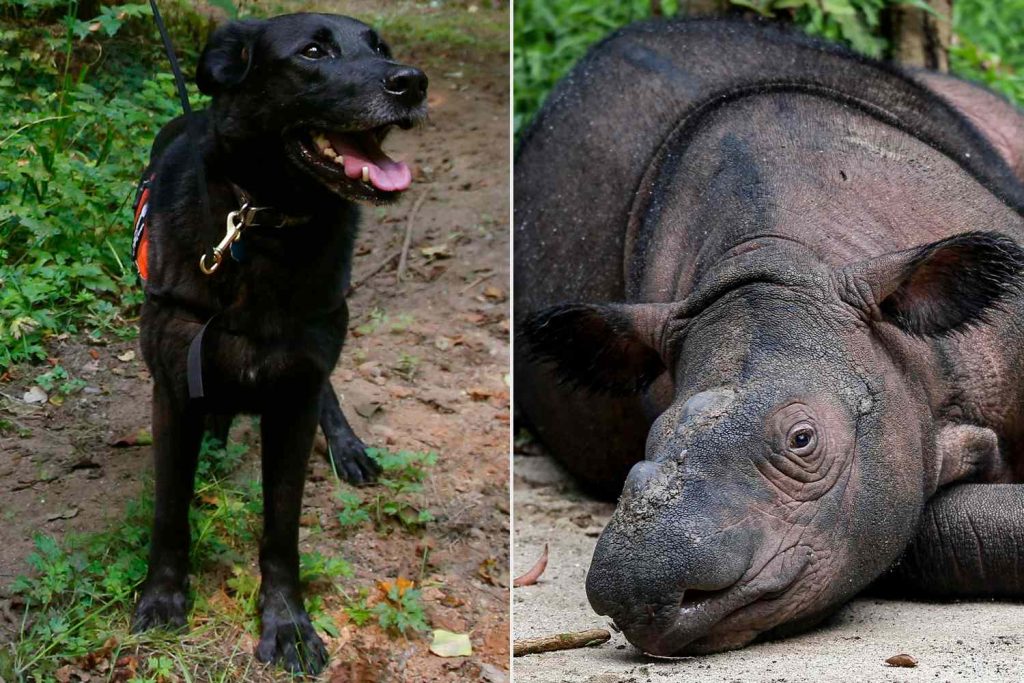:max_bytes(150000):strip_icc():format(jpeg)/Sniffer-Dogs-May-Have-Rediscovered-Lost-Rhino-Population-1-082225-796a78a1194e46d9aaa8699b5da6973b.jpg)
NEED TO KNOW
- The International Rhino Foundation teamed up with sniffer dogs from Working Dogs for Conservation to locate Sumatran rhinos
- The dogs “have discovered what are believed to be several heaps of Sumatran rhino dung” in Indonesia, according to an Aug. 18 report from conservation news outlet Mongabay
- Working Dogs for Conservation explained that “dogs can have upwards of 220 million [scent receptors], which is why they can detect a single teaspoon of sugar in a million gallons of water”
With dogged determination, dogs sniffing for signs of the “critically endangered” Sumatran rhinos may have found the elusive wild animals.
Earlier this month, the International Rhino Foundation (IRF) teamed up with sniffer dogs from Working Dogs for Conservation, the Yayasan Badak Indonesia and the Indonesian Ministry of Forestry to find the lost rhino population in Indonesia’s Way Kambas National Park.
“We’re deploying highly trained scent-detection dogs to search for signs of the elusive and critically endangered Sumatran rhino,” the IRF wrote on Facebook on Aug. 6. “Fewer than 50 Sumatran rhinos remain in the world.”
Hyping up the sniffer dogs, the IRF added, “Finding them in the dense rainforest is no small task but with their incredible sense of smell, these dogs are helping conservationists locate rhinos (or their scat!).”
PERDIANSYAH/AFP via Getty
Now, according to an Aug. 18 report from conservation news outlet Mongabay, the dogs “have discovered what are believed to be several heaps of Sumatran rhino dung,” which has been confirmed by one test to have come from a Sumatran rhino.
However, two more tests on the scat are needed for final confirmation from the Indonesian government.
“Quite honestly, in my opinion, I trust the dogs,” Nina Fascione, the IRF’s executive director, told the outlet. “The dogs were trained on rhino’s scat. They found what everybody believes is rhino’s scat … it’s really good news.”
Mongabay said two dogs, Yagi and Quinn, found the dung in two days.
Michael Macor/San Francisco Chronicle via Getty
Working Dogs for Conservation explained on its website that “dogs can have upwards of 220 million [scent receptors], which is why they can detect a single teaspoon of sugar in a million gallons of water. Where [humans] experience the world visually, dogs perceive a detailed scentscape.”
“Dogs can smell continuously through their noses (not just on the inhale, as we do),” the website continued. “They can even determine which nostril an odor arrived in first, which helps them locate a scent in space. They also have an additional olfactory organ and dedicated processing center in the brain devoted just to scenting pheromones.”
Never miss a story — sign up for PEOPLE’s free daily newsletter to stay up-to-date on the best of what PEOPLE has to offer, from celebrity news to compelling human interest stories.
Pete Coppolillo, executive director at Working Dogs for Conservation, expressed his excitement, telling Mongabay, “I feel greedy saying it, but I’m hoping there’s more than one rhino.”
He added, “Can you imagine if we confirm breeding? This is the stuff we conservationists live for!”

